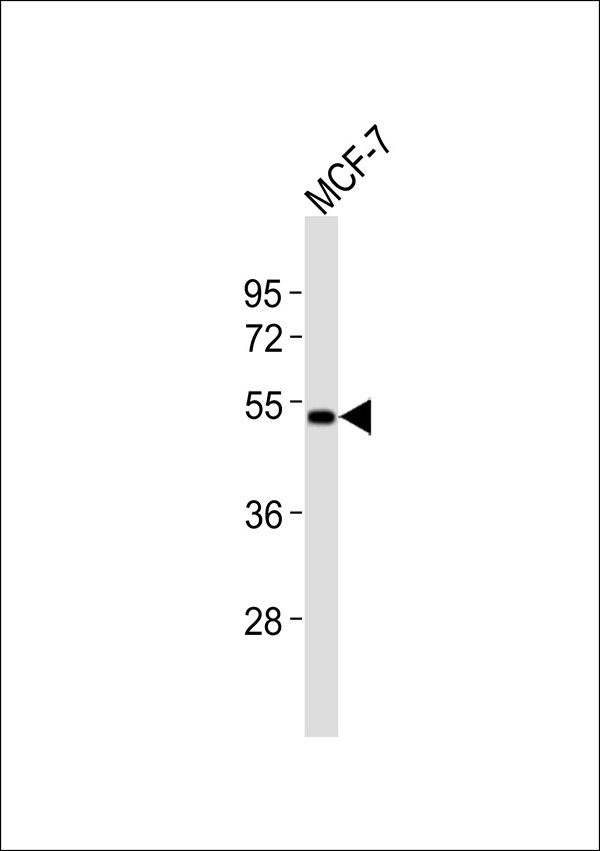CD174 Antibody
Purified Rabbit Polyclonal Antibody (Pab)
- SPECIFICATION
- CITATIONS
- PROTOCOLS
- BACKGROUND

Application
| WB |
|---|---|
| Primary Accession | P21217 |
| Reactivity | Human, Mouse, Rat |
| Host | Rabbit |
| Clonality | Polyclonal |
| Calculated MW | 42 KDa |
| Antigen Region | 71 - 130 aa |
| Gene ID | 2525 |
|---|---|
| Other Names | Galactoside 3(4)-L-fucosyltransferase, Blood group Lewis alpha-4-fucosyltransferase, Lewis FT, Fucosyltransferase 3, Fucosyltransferase III, FucT-III, FUT3, FT3B, LE |
| Target/Specificity | KLH-conjugated synthetic peptide encompassing a sequence within the center region of human CD174. The exact sequence is proprietary. |
| Dilution | WB~~ 1:1000 |
| Format | 0.01M PBS, pH 7.2, 0.09% (W/V) Sodium azide, Glycerol 50% |
| Storage | Store at -20 °C.Stable for 12 months from date of receipt |
| Name | FUT3 (HGNC:4014) |
|---|---|
| Synonyms | FT3B, LE |
| Function | Catalyzes the transfer of L-fucose, from a guanosine diphosphate-beta-L-fucose, to both the subterminal N-acetyl glucosamine (GlcNAc) of type 1 chain (beta-D-Gal-(1->3)-beta-D-GlcNAc) glycolipids and oligosaccharides via an alpha(1,4) linkage, and the subterminal glucose (Glc) or GlcNAc of type 2 chain (beta-D-Gal-(1->4)-beta-D- GlcNAc) oligosaccharides via an alpha(1,3) linkage, independently of the presence of terminal alpha-L-fucosyl-(1,2) moieties on the terminal galactose of these acceptors (PubMed:11058871, PubMed:12668675, PubMed:1977660). Through its catalytic activity, participates in the synthesis of antigens of the Lewis blood group system, i.e. Lewis a (Le(a)), lewis b (Le(b)), Lewis x/SSEA-1 (Le(x)) and lewis y (Le(y)) antigens (PubMed:11058871, PubMed:12668675, PubMed:1977660). Also catalyzes the transfer of L-fucose to subterminal GlcNAc of sialyl- and disialyl-lactotetraosylceramide to produce sialyl Lewis a (sLe(a)) and disialyl Lewis a via an alpha(1,4) linkage and therefore may regulate cell surface sLe(a) expression and consequently regulates adhesive properties to E-selectin, cell proliferation and migration (PubMed:11058871, PubMed:12668675, PubMed:27453266). Catalyzes the transfer of an L-fucose to 3'-sialyl-N-acetyllactosamine by an alpha(1,3) linkage, which allows the formation of sialyl-Lewis x structure and therefore may regulate the sialyl-Lewis x surface antigen expression and consequently adhesive properties to E-selectin (PubMed:11058871, PubMed:29593094). Prefers type 1 chain over type 2 acceptors (PubMed:7721776). Type 1 tetrasaccharide is a better acceptor than type 1 disaccharide suggesting that a beta anomeric configuration of GlcNAc in the substrate is preferred (PubMed:7721776). Lewis- positive (Le(+)) individuals have an active enzyme while Lewis-negative (Le(-)) individuals have an inactive enzyme (PubMed:1977660). |
| Cellular Location | Golgi apparatus, Golgi stack membrane; Single- pass type II membrane protein Note=Membrane-bound form in trans cisternae of Golgi |
| Tissue Location | Highly expressed in stomach, colon, small intestine, lung and kidney and to a lesser extent in salivary gland, bladder, uterus and liver. |

Thousands of laboratories across the world have published research that depended on the performance of antibodies from Abcepta to advance their research. Check out links to articles that cite our products in major peer-reviewed journals, organized by research category.
info@abcepta.com, and receive a free "I Love Antibodies" mug.
Provided below are standard protocols that you may find useful for product applications.
Background
May catalyze alpha-1,3 and alpha-1,4 glycosidic linkages involved in the expression of Vim-2, Lewis A, Lewis B, sialyl Lewis X and Lewis X/SSEA-1 antigens. May be involved in blood group Lewis determination; Lewis-positive (Le(+)) individuals have an active enzyme while Lewis-negative (Le(-)) individuals have an inactive enzyme. Also acts on the corresponding 1,4-galactosyl derivative, forming 1,3-L-fucosyl links.
References
Kukowska-Latallo J.F.,et al.Genes Dev. 4:1288-1303(1990).
Cameron H.S.,et al.J. Biol. Chem. 270:20112-20122(1995).
Rahim I.,et al.Submitted (FEB-1999) to the EMBL/GenBank/DDBJ databases.
Matzhold E.M.,et al.Submitted (SEP-2008) to the EMBL/GenBank/DDBJ databases.
Grimwood J.,et al.Nature 428:529-535(2004).
If you have used an Abcepta product and would like to share how it has performed, please click on the "Submit Review" button and provide the requested information. Our staff will examine and post your review and contact you if needed.
If you have any additional inquiries please email technical services at tech@abcepta.com.













 Foundational characteristics of cancer include proliferation, angiogenesis, migration, evasion of apoptosis, and cellular immortality. Find key markers for these cellular processes and antibodies to detect them.
Foundational characteristics of cancer include proliferation, angiogenesis, migration, evasion of apoptosis, and cellular immortality. Find key markers for these cellular processes and antibodies to detect them. The SUMOplot™ Analysis Program predicts and scores sumoylation sites in your protein. SUMOylation is a post-translational modification involved in various cellular processes, such as nuclear-cytosolic transport, transcriptional regulation, apoptosis, protein stability, response to stress, and progression through the cell cycle.
The SUMOplot™ Analysis Program predicts and scores sumoylation sites in your protein. SUMOylation is a post-translational modification involved in various cellular processes, such as nuclear-cytosolic transport, transcriptional regulation, apoptosis, protein stability, response to stress, and progression through the cell cycle. The Autophagy Receptor Motif Plotter predicts and scores autophagy receptor binding sites in your protein. Identifying proteins connected to this pathway is critical to understanding the role of autophagy in physiological as well as pathological processes such as development, differentiation, neurodegenerative diseases, stress, infection, and cancer.
The Autophagy Receptor Motif Plotter predicts and scores autophagy receptor binding sites in your protein. Identifying proteins connected to this pathway is critical to understanding the role of autophagy in physiological as well as pathological processes such as development, differentiation, neurodegenerative diseases, stress, infection, and cancer.


